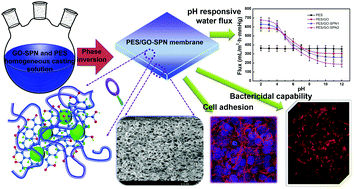Graphene oxide linked sulfonate-based polyanionic nanogels as biocompatible, robust and versatile modifiers of ultrafiltration membranes†
Abstract
Aiming to enhance the current biological performances of ultrafiltration membranes, in this study, a new kind of graphene oxide linked sulfonate-based polyanionic nanogel (GO-SPN) was fabricated by free radical cross-linked copolymerization. Then, GO-SPN embedded polyethersulfone (PES/GO-SPN) ultrafiltration (UF) membranes were achieved through one-pot PES dissolution and interpenetration, followed by a liquid–liquid phase inversion method. The GO-SPN modified UF membranes exhibited increased porous cross-section structures with a pH-dependent water flux. Notably, the modified UF membranes showed excellent in vitro hemocompatibility and cytocompatibility performances, such as good anti-coagulant activity, red blood cell compatibility (with very low hemolysis ratios below 0.2%), anti-platelet adhesion and activation, low inflammation potential, and high endothelial cell compatibility. Moreover, to confirm the actual application potential of the GO-SPN embedded membranes in diverse fields, we also examined the performances of PES/GO-SPN composite hollow fiber UF membranes. It was validated that the mechanical properties of the hollow fiber UF membranes (tensile strength higher than 1.2 MPa) could satisfy the demands of industrial or clinical applications. Furthermore, the modified membranes exhibited versatile ability, i.e. they could load Ag-nanoparticles which bestowed them with excellent bactericidal capability (about 97%) against both Staphylococcus aureus (S. aureus) and Escherichia coli (E. coli). Due to the integration of hemo- and cyto-compatibility, good mechanical strength as well as bactericidal capability, the GO-SPN embedded membranes offer a new protocol to greatly extend the application potential of UF membranes in fields ranging from clinical hemodialysis to water purification.


 Please wait while we load your content...
Please wait while we load your content...